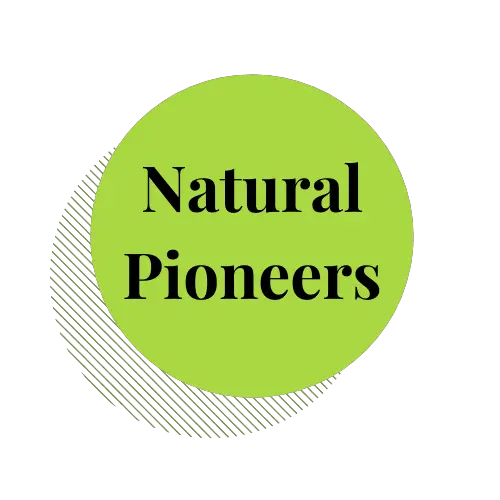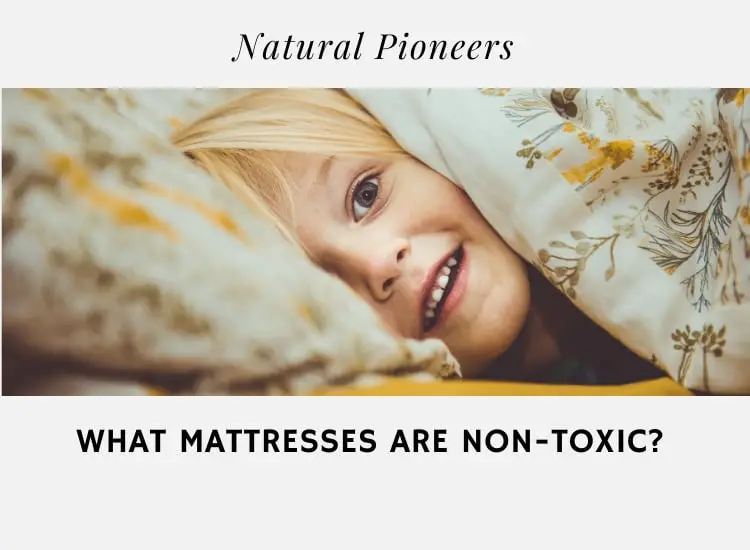
Is your mattress safe? I found out that mine wasn’t and took immediate action. We will tell you about dangerous chemicals in mattresses, what fabrics and certifications to look for and non-toxic mattress brands (with prices) you can trust.
Non-toxic mattresses are GOTS-certified (Global Organic Textile Standard) or GOLS-certified (Global Organic Latex Standard). Non-toxic mattress brands include Avocado, Happsy, My Green Mattress, Naturepedic, Plush Beds & Soaring Heart. Prices for safe, chemical-free mattresses start at 899 USD.
Let’s learn and understand how mattresses can be a health hazard in our home.
1. Dangerous Chemicals In Mattresses
We spend one third of our lives sleeping, on average 26 years. Throughout that time you have the choice to sleep on a safe mattress or on one that emits toxic fumes. The first step, however, is to get educated about the mattress you’re currently sleeping on. Let’s take a look at dangerous chemicals in mattresses.
Dangerous Chemicals In Mattresses Include:
- Polyurethane foam
- Volatile organic compounds (VOCs)
- Flame retardant chemicals
- PVC or vinyl covers
What is dangerous about these chemicals used in mattresses? These chemicals can emit volatile organic compounds (VOCs), damage reproductive systems in kids, cause respiratory irritation, are linked to cancer, hormone disruption & adverse effects on the immune system. [1]
Polyurethane foam is used in most mattresses on the market. You also find polyurethane foam in pillows, couches, and chair cushions. Polyurethane is petroleum-basend and contains VOCs, causing immediate health effects like headaches, eye, nose and throat irritation, loss of coordination, asthma exacerbation and nausea.
Possible longer-term effects include liver, kidney, and central nervous system damage, and cancer. [2]
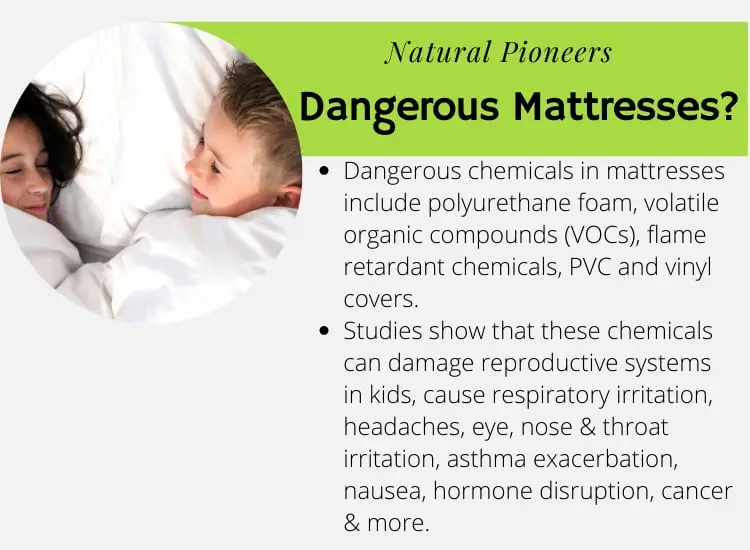
>> Learn more about non-toxic living
I had been sleeping on a polyurethane foam pillow for over a year before conducting this research on chemicals in mattresses. And I totally bought into the claim that it will improve my sleep quality as it holds the contours of my head and neck, relieving pressure, and distributing my weight more evenly.
I took immediate action, and even before publishing this article, I researched and bought toxin-free pillows for my family. We are now sleeping on these: Naturepedic Organic Cotton Pillow. My husband is a big sleeper and very picky about his bedtime routine and pillow. After the first night I asked him what he thought of his new pillow, and he said: “They are awesome. I sleep very well with them!”
The Take-Away: Dangerous chemicals in mattresses include polyurethane foam, volatile organic compounds (VOCs), flame retardant chemicals, PVC and vinyl covers. Studies show that these chemicals can damage reproductive systems in kids, cause respiratory irritation, headaches, eye, nose & throat irritation, loss of coordination, asthma exacerbation, nausea, hormone disruption & adverse effects on the immune system. Long-term effects include liver, kidney & central nervous system damage, and cancer.
2. What Is a Non-Toxic Mattress?
Without weeks worth of reading studies and researching chemicals or the help of a non-toxic professional, the mattress market looks like a nontransparent jungle!
Here’s some hard rules that will help you pick the right mattress. We’ll dive in to specific brands later on.
A Non-Toxic Mattress Contains
- No less than 95% certified organic content
- No polyurethane foam
- No added chemical flame retardants
- No added fragrances or antimicrobials, and
- No PVC or vinyl. [3]
It’s a long list of chemicals and things to avoid, I know. However, it’s a long-term investment in your health. Strictly avoiding these chemicals is especially important as mattresses and pillows with foam (made from polyurethane) are never off-gassed. They emit more toxins as the foam degrades!
Now that we know what we should avoid, let’s talk about what materials we want to have in our mattresses.
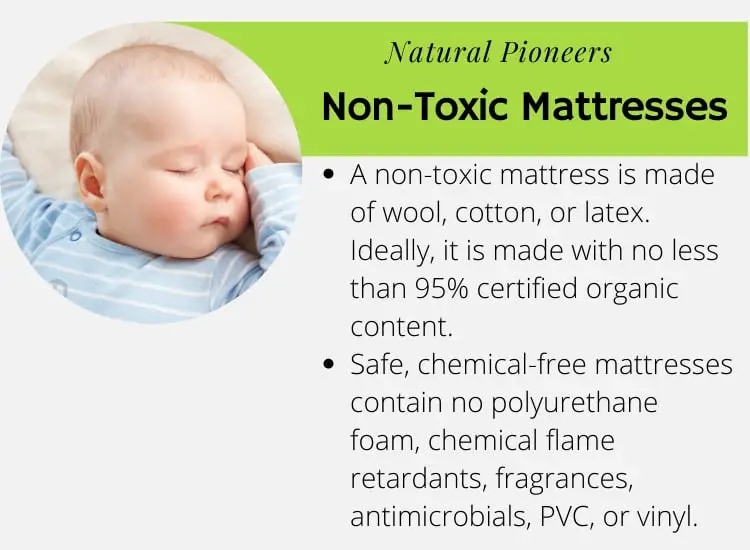
>> Learn more about non-toxic beauty
Fabrics In Non-Toxic Mattresses
- Organic wool – wool is a great choice as it is dust mite resistant as well as flame resistant.
- Cotton! If you can, choose organic cotton. While it is more costly than regular cotton, you know for sure that it has not been treated with chemicals.
- 100% natural latex. Latex is made from rubber trees. Stay away from latex blends, as some of them contain petroleum-based polyurethane.
Let’s now see what mattress certifications we should look out for when it comes to choosing a non-toxic mattress for you and your family.
The Take-Away: A non-toxic mattress is made of wool, cotton, or latex. Ideally, it is made with no less than 95% certified organic content. It contains no polyurethane foam, chemical flame retardants, fragrances, antimicrobials, PVC, or vinyl.
Non-Toxic Mattress Certifications
There are tons of certifications for mattresses – some of which are great indicators for non-toxic materials, and then some that are pretty much worthless. The most ridiculous ones are those where the manufacturer itself has created a certification (why use a neutral third party in the first place?) along with empty greenwashing claims (anyone can use the words “natural,” “green”, “eco” and even “organic”).
We’ll keep it short and go into the certifications to look for. If you stick with those, you’re definitely on the safe side. Therefore, we’ll neglect all the nonsense certifications in this article and provide you solely with the information and certifications you need.
The Best Certifications For Non-Toxic Mattresses
- GOTS (Global Organic Textile Standard): The #1 worldwide leading textile processing certification you want to look for. GOTS certified mattresses are 95% organic and the textiles in use are being tracked every step of the way. Why does it matter? Because organic mattresses have never even touched a chemical that could potentially harm our health. GOTS also has strict ecological and social standards, and prohibits chemical flame retardants and foam (polyurethane).
- GOLS (Global Organic Latex Standard): GOLS is a materials & processing standard for organic latex and finished latex foam and crucial to have if you are looking for a latex mattress. This certification ensures that a mattress with latex is made of 95% organic latex. Some natural-latex mattresses may have both, the GOTS and GOLS labels.
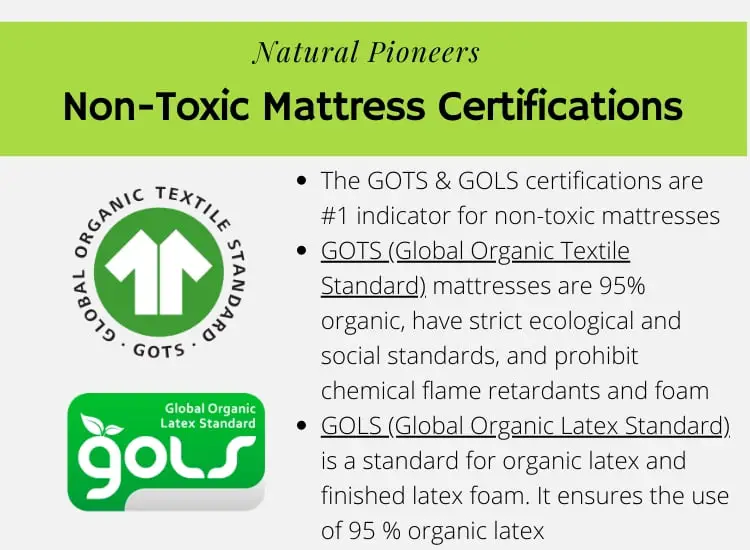
>> Learn more about non-toxic dish soap
That’s it! It is as simple as that. Just look for the GOTS or GOLS certificate on your mattress and you’re good to go. Make sure the certification is on the mattress itself, and not just displayed on a company’s website which may only refer certain mattresses.
While you’re out looking for your new mattress, you’ll likely come across certifications like Oeko-Tex Standard 100, Greenguard (Gold), Organic Content Standard 100, NAOMI and CertiPUR US. While these are nice to have, the GOTS and GOLS logos already account for all the manufacturing practices of these certifications. [4]
Now, it’s time to see what mattress brands we can trust when it comes to high quality, non-toxic mattresses.
The Take-Away: The GOTS & GOLS certifications are the #1 indicator for non-toxic mattresses. GOTS (Global Organic Textile Standard) mattresses are 95% organic, have strict ecological and social standards, and prohibit chemical flame retardants and foam (polyurethane). GOLS (Global Organic Latex Standard) is a processing standard for organic latex and finished latex foam. If you consider getting a latex mattress, this certification ensures 95 % organic latex. Many natural-latex mattresses may have both, the GOTS and GOLS labels.
4. Non-Toxic Mattress Brands
If you’re looking for a fast track, here’s a current list of non-toxic mattress brands. My family sleeps on Avocado and Naturepedic mattresses. However, all of these brands listed below are great options. These mattress brands are safe, non-toxic, and incredibly comfortable. Many of these brands are also known to giving back to those in need and local communities.

Non-Toxic Mattress Brands | In Alphabetical Order
Avocado
Avocado holds GOTS and GOLS certifications and is a more budget friendly option for non-toxic mattresses. Their adult mattresses run from 1,399 USD to 1,799 USD.
Happsy
Happsy is made by Naturepedic and currently offers their mattress-in-a-box with a 120-day trial period. They are GOTS and GOLS certified and their queens start at 1,399 USD.
My Green Mattress
My Green Mattress is both, GOTS & GOLS certified and one of the most budget friendly options out there. Their queens run form 899 USD to 1,299 USD
Naturepedic
Naturepedic holds both, GOTS and GOLS certifications. Naturepedic has many options available and their adult mattresses range from 1,999 to 8,999 USD for their luxury mattresses.
Plush Beds
Plushbeds is GOTS and GOLS verified and has been featured in many magazines. Be aware that they also sell memory foam and other regular mattresses that contain toxic chemicals. Their natural & organic queen mattresses run from 2,399 USD to 3,399 USD.
Soaring Heart
This Seattle based brand focuses on organic and latex mattresses. They have both, GOLS and GOTS certifications. And they have nothing to hide: all materials are discloses on their website. These mattresses run from roughly 999 USD to 5,999 USD and will last you a long time.
The Take Away: Non-toxic mattresses are GOTS-certified (Global Organic Textile Standard) or GOLS-certified (Global Organic Latex Standard). Non-toxic mattress brands include Avocado, Happsy, My Green Mattress, Naturepedic, Plush Beds & Soaring Heart. Prices for safe, chemical-free mattresses start at 899 USD.
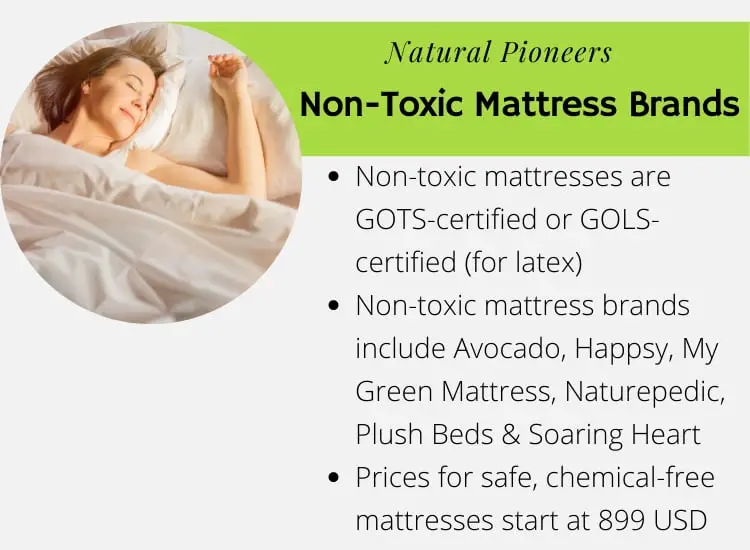
>> Learn more about antibacterial hand soap
5. Conclusion
Dangerous chemicals in mattresses include polyurethane foam, volatile organic compounds (VOCs), flame retardant chemicals, PVC and vinyl covers. Studies show that these chemicals can damage reproductive systems in kids, cause respiratory irritation, headaches, eye, nose & throat irritation, loss of coordination, asthma exacerbation, nausea, hormone disruption & adverse effects on the immune system. Long-term effects include liver, kidney & central nervous system damage, and cancer.
A non-toxic mattress is made of wool, cotton, or latex. Ideally, it is made with no less than 95% certified organic content. It contains no polyurethane foam, chemical flame retardants, fragrances, antimicrobials, PVC, or vinyl.
The GOTS & GOLS certifications are the #1 indicator for non-toxic mattresses. GOTS (Global Organic Textile Standard) mattresses are 95% organic, have strict ecological and social standards, and prohibit chemical flame retardants and foam (polyurethane). GOLS (Global Organic Latex Standard) is a processing standard for organic latex and finished latex foam. If you consider getting a latex mattress, this certification ensures it is made of 95 % organic latex. Many natural-latex mattresses may have both, the GOTS and GOLS labels.
Non-toxic mattress brands include Avocado, Happsy, My Green Mattress, Naturepedic, Plush Beds & Soaring Heart. Prices for safe, chemical-free mattresses start at 899 USD.
